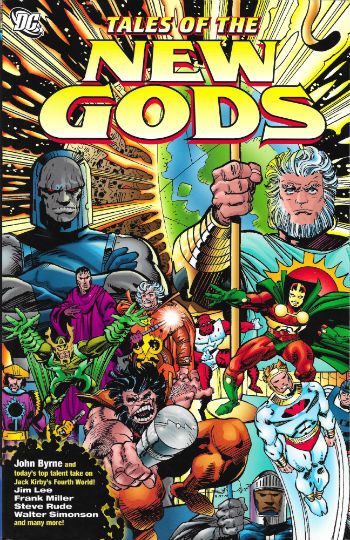"Seems Like Even The GODS Have Their ACCIDENTS!" COMICS! Sometimes The King Is Still Dead!
/“Tarru!” to you, too!! Just look at the creators on this thing! It’s like the comic book equivalent of one of those Irwin Allen films where Steve McQueen and Paul Newman jockey for top billing, Fred Astaire tumbles burning out of a lift, Michael Caine shouts about bloody, bloody bees and Gene Hackman tells God off with his steam blistered fists raised. It isn't a movie, but is it a disaster?
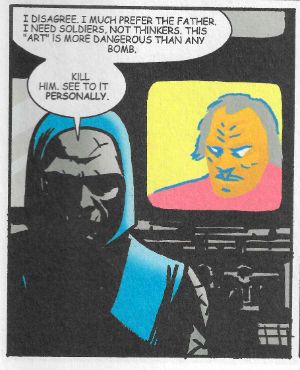 TALES OF THE NEW GODS by John Paul Leon, Kevin McCarthy, John Workman & Tatjana Wood
TALES OF THE NEW GODS by John Paul Leon, Kevin McCarthy, John Workman & Tatjana Wood
Anyway this… TALES OF THE NEW GODS Pencilled by Steve Rude, John Byrne, Walter Simonson, Ron Wagner, Frank Miller, Dave Gibbons, Erik Larsen, Howard Victor Chaykin, Rob Liefeld, Art Adams, Jim Lee, John Paul Leon, Allen Milgrom, Eddie Campbell & Steve Ditko Inked by Mike Royer, John Byrne, Walter Simonson, Ray Kryssing, Frnk Miller, Dave Gibbons, Al Gordon, Howard Chaykin, Norm Rapmund, Art Adams, Scott Williams, John Paul Leon, Klaus Janson, Eddie Campbell & Mick Gray Written by Mark Evanier, John Byrne, Walter Simonson, Eric Stephenson, Walter Simonson with Howard Victor Chaykin, Jeph Loeb, Kevin McCarthy & Mark Millar Lettered by Todd Klein, John Byrne, John Workman, Clem Robins, Ken Bruzenak & Richard Starkings Coloured by Anthony Tollin, Lee Loughridge, Noelle Giddings, Sherilyn Van Valkenburgh, Tatjana Wood, Buzz Setzer & Drew Moore Collecting stories from Mister Miracle Special, Jack Kirby's Fourth World #2-11,13-20, and Orion #3-4, #6-8, #10, #12, #15, #18-19. Plus, a never-before-published short story by The Socialist Mark Millar with art by Steve Ditko and Mick Gray DC COMICS, $19.99 (2008) The Fourth World created by Jack Kirby Superman created by Jerry Siegel & Joe Shuster
In 1970 Jack Kirby, finally tiring of Marvel’s inability accord him decent treatment, chose to go to DC Comics. It was there that he began the greatest phase of his many great phases of work, a phase I have taken the liberty of dubbing with fierce precision “1970s Jack Kirby”. While at DC this phase encompassed his majestically epic work on The Demon, Omac, The Sandman, Kamandi, First Issue Special, The Losers and of course, and most pertinently, Jack Kirby’s Fourth World books. Jack Kirby’s Fourth World concept took the form of an interlocking suite of books (Jimmy Olsen, New Gods, Mister Miracle and Forever People) which were intended to be collected in a series of bound volumes for bookstores and, thus, a wider audience. In 2015 this is common practice for any old trex but in 1970 this kind of thing never happened. And it didn’t happen with Jack Kirby’s Fourth World either.
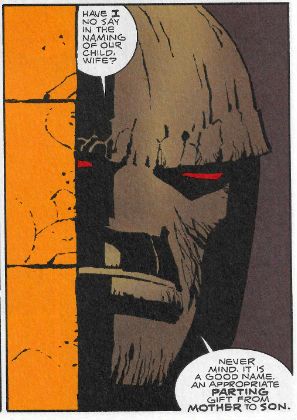 TALES OF THE NEW GODS by Frank Miller, John Workman & Sherilyn Van Valkenburgh
TALES OF THE NEW GODS by Frank Miller, John Workman & Sherilyn Van Valkenburgh
Controversy still smoulders regarding whether these books were successful or not but it’s all a bit moot as the last of them was cancelled in 1973. Short lived but much loved, Jack Kirby’s original Fourth World work is currently available in a series of four TPs from DC Comics. Sometimes they are even seen in bookshops as Jack Kirby originally envisaged. Post-Kirby DC has attempted periodically to revive the various Fourth World IPs with, to be kind, varying levels of success. Remember that time Jim Starlin inflated the New Gods’ thighs and killed them all? No, me neither. But, you know, that’s what comics companies do; no harm, no foul. And if they make good comics while doing so, then everyone wins. Tales of The New Gods reprints, somewhat haphazardly, some of the best illustrated attempts at being Jack Kirby. The results are variable, but as awful as a couple of them are they are all better than my attempt at being Jack Kirby, an attempt which starts and ends with not being able to drive.
 TALES OF THE NEW GODS by Howard Victor Chaykin, Walter Simonson, Ken Bruzenak & Sherilyn Van Valkenburgh
TALES OF THE NEW GODS by Howard Victor Chaykin, Walter Simonson, Ken Bruzenak & Sherilyn Van Valkenburgh
MISTER MIRACLE SPECIAL (Pages 3 -42)
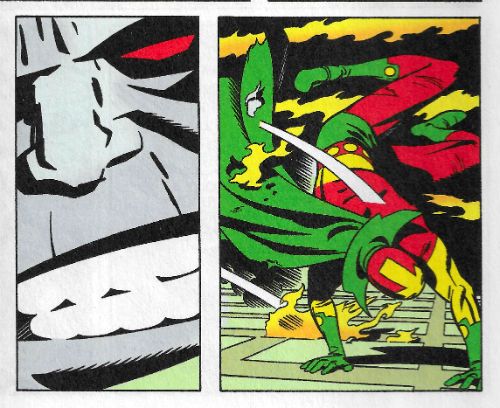 Mister Miracle Special by Steve Rude, Mike Royer, Mark Evanier, Todd Klein & Anthony Tollin
Mister Miracle Special by Steve Rude, Mike Royer, Mark Evanier, Todd Klein & Anthony Tollin
Given it’s written by Mark Evanier this volume opener is, as you might, expect, an exercise in respect. It doesn’t do anything new but then it doesn’t want to. It’s kind of a primer on Mister Miracle, as though the whole run were truncated to one book. It could work as a self-contained summation of that whole Mister Miracle deal or as a scene setter for a new series. Either way it’s a hectic romp filled with knowingly cornball humour, tinges of darkness, flamboyantly ridiculous death traps and inexplicable escapes from certain death. Mostly though, it’s all about Steve Rude’s art which here is as much of a politely inflamed (sometimes even a tentatively frenetic) collision of Kirby and Toth as it ever has been. It’s wild and wacky stuff adroitly sold. But Rude’s art, like Evanier’s script, as madcap as it all gets remains too tethered to reality to ever risk lifting both feet clear of solid ground and floating “out there!!!” like the King. It’s still wonderful stuff, just different. It lacks the irreverent insanity Kirby would suddenly plunge into without warning. Basically there’s nothing like that bad guy called “Merkin” but then to be honest I’m entirely comfortable with the idea that Jack Kirby knew what a pubic wig was. Rude & Evanier’s strip is happy enough to be a tribute and homage to Mister Miracle and I’m happy enough to have it be such. GOOD!
JACK KIRBY’s FOURTH WORLD #2-20 (pages 43 - 147)
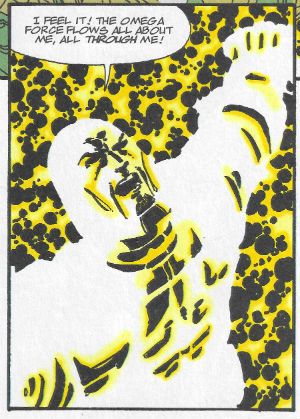 TALES OF THE NEW GODS by John Byrne & lee Loughridge
TALES OF THE NEW GODS by John Byrne & lee Loughridge
In 1997 John Byrne started vigorously emitting issues of a series entitled Jack Kirby’s Fourth World. This was a dream come true; for John Byrne anyway. I’m not saying John Byrne seems to have an unhealthy fixation with bettering Jack Kirby but it wouldn’t surprise me if he was often mistaken in the street for a 1975 John Huston movie adapted from the works of Rudyard Kipling and starring Sean Connery, Michael Caine and Christopher Plummer. Phew! While John Byrne’s no Jack Kirby (who is? No one.) he’s very definitely John Byrne, and John Byrne is a talented man in his own right. So there’s a certain level of fascination in watching him get stuck into Kirby’s mythology. And then fascination turns to dismay as you realise he is actually stuck in Kirby’s mythos. While (I assume) the main stories in his series progressed Kirby’s mythos what we have here are the back-ups and these are more concerned with regressing and filling in the background to The Fourth World. John Byrne, sadly, suffers from Roy Thomas Disease and so that goes someway to explaining why he backfills the backstory of Scott Free, Metron and The Forever People for example, but only a truly unnerving level of hubris can explain the fact that John Byrne gave Darkseid an origin.
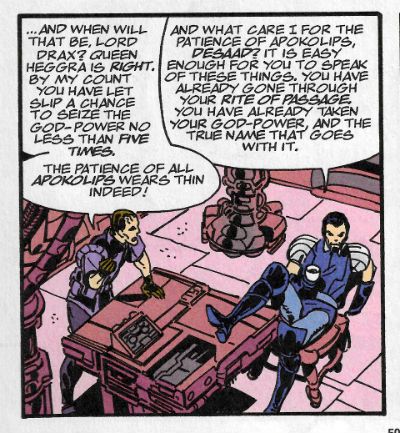 TALES OF THE NEW GODS by John Byrne & Noelle Giddings
TALES OF THE NEW GODS by John Byrne & Noelle Giddings
As origins for Darkseid go it’s not bad; there’s even a surprise - it turns out to be someone else’s origin too. Unfortunately, and fundamentally, I don’t think Darkseid needed an origin. I think Darkseid works better as a granite faced mini-skirted embodiment of the fascistic darkness ready to pounce when civilisation becomes complacent. Which, to be fair, none of which Byrne has changed, but after reading his origin the looming brute is forever after diminished by the thought of the henpecked sneak he came from. What’s important is (simply) that Darkseid IS not (convolutedly) who Darkseid was. Whether by design, sheer forward momentum, or a fortuitous combination of the two, Kirby left loads of spaces both within and around the Fourth World; spaces for the imagination of his readers to fill. Kirby’s creations invited reader participation because Kirby believed indiscriminately in imagination. John Byrne also believes in imagination, but only in his. Again and again, with a fixity of purpose that stifles any imaginative flex Byrne returns to the spaces within Kirby’s stories and starts filling them in, like graves.
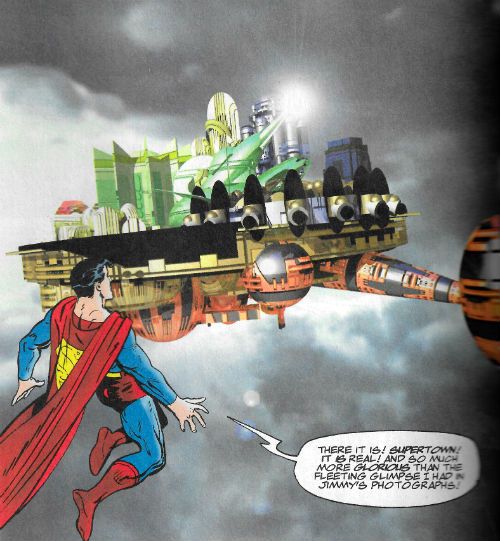 TALES OF THE NEW GODS by John Byrne & Noelle Giddings
TALES OF THE NEW GODS by John Byrne & Noelle Giddings
Of course Kirby would also go back, when able, to show what was past. But when he did it we got The Pact; when he did it they were revelations not explanations. Kirby’s additions opened up his narrative, Byrne’s additions all feel like a door has been slammed shut somewhere. As Byrne’s pages pass there’s a sense of narrative claustrophobia as the characters, characters who more than most characters should have access to the infinite, run out of room, they risk becoming entombed in their own narrative. Visually this impression is also, unfortunately, true; great wodges of stilted and circumlocutious dialogue hem his figures into his badly planned panels with dismaying frequency. Which is a shame because I like John Byrne’s art here, when I can see it. It has an appealingly loose and impromptu aspect which invests it with more energy than can be entirely stifled by the narrative slog it inhabits. Sometimes Byrne will surprise, with the early Apokolips scenes being visually lively, or by drawing more birds in the sky during the old timey scenes, which feels right (I don’t know, I wasn’t there). Then he’ll dismay with a character called Francine Goodbody, and the sudden threat of John Byrne penning some period sauce about dirty earls and bosomy maids turns your ears scarlet with dismay. Byrne's fatal miscalculation is to let Walter Simonson provide one of the backups, whereupon Simonson shows how it should be done. Thanks to a lightness of touch and his usual impeccable storytelling wizardry Simonson explains how Kanto came to dress like a Borgia in tale which is both hilariously obvious and melodramatically arresting. It’s a bit of a shame really as Byrne’s clearly into this stuff. He even goes so far as to update the Kirby collage technique with a couple of images combining his drawn figures with CGI of the time. By the end of this section though we have found a talent capable of invigorating Kirby’s mythos anew. Unfortunately it wasn’t John Byrne. OKAY!
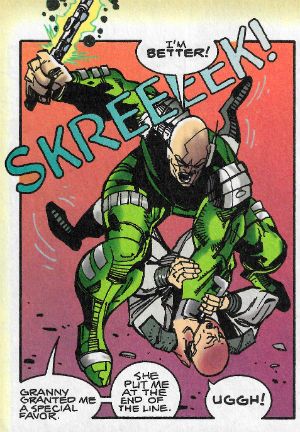 TALES OF THE NEW GODS by Walter Simonson, John Workman & Noelle Giddings
TALES OF THE NEW GODS by Walter Simonson, John Workman & Noelle Giddings
Orion #3-4, #6-8, #10, #12, #15, #18-19. (Pages 148 - 207)
No, in a bitter twist worthy of The Source itself , it was Walter Simonson! In 2000 Walter Simonson began his Orion series. This focused on the angry pup of Darkseid while also flopping happily about in the wider Fourth World concepts. As is usual in Comics quality had nothing to do with sales and it ended in 2002. Taking his cue from Byrne’s series there was a main strip and then a backup. I guess Walter Simonson is a lot more amenable than John Byrne because a cavalcade of comics creators muck in to help him out on them. I know because I typed all their names in up there. That’s my free time that is; you’re very welcome. Rather than the main strips then it is these backups which are presented here. Unfortunately while Simonson made the more sensible decision to have his backups inform and augment events in the main strip rather than compete directly with the King, that does mean that reading them here, divorced from their original context can be less than satisfying.
 TALES OF THE NEW GODS by Eddie Campbell, Walter Simonson, Pete Mullins, John Workman & Tatjana Wood
TALES OF THE NEW GODS by Eddie Campbell, Walter Simonson, Pete Mullins, John Workman & Tatjana Wood
Some stand alone and read well such as Frank Miller’s typically, and appropriately, brutally drawn birth of Orion which, again opens up rather than closes off story possibilities. The John Paul Leon strip is his usual wonderful balancing act between extremities of light and dark with a script by Kevin McCarthy which is a nice bit of business about fathers, sons, and the place of art under Darkseid (beneath his boot). Mostly though they are just a bit of fun where you enjoy the performance as much as the story. Howard Victor Chaykin characteristically provides pages involving a blue skinned sexy lady which involve domination, badinage and a messy ending. Of most interest there is the crucial part Ken Bruzenak’s letters play in deciphering the climax and the way the printing serves Chaykin so poorly that the climax has to be deciphered. Otherwise Eddie Campbell draws Darkseid, Arthur Adams channels Jean Giraud and, well, it’s just nice seeing most of these folk having fun. There’s a whole two duffers which isn’t bad by any stretch. Liefeld & Loeb remain inept and as much love as I have for the work of Steve Ditko either he isn’t really trying here or the thick inks by Mick Gray destroy any of his signature fluidity. In fact the best bit of this final (previously unpublished!) strip is that Ditko is teamed up with Mark Millar. Pairing someone as ideologically resolute as Steve Ditko with, well, Mark Millar is a black joke worthy of Darkseid his bad self. Overall this section Is VERY GOOD! which by my calculations makes the whole book - GOOD!
(NOTE: But the whole Simonson Orion run is shortly to be released by DC as an Omnibus. Knowhumsayin’? Because that thing will be fat with - COMICS!!!)


